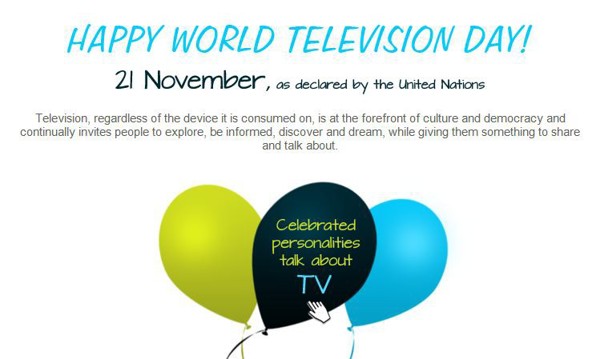World Television Day 2024 is on Thursday, November 21, 2024: Television ratings.?
Thursday, November 21, 2024 is World Television Day 2024.
As an Amazon Associate I earn from qualifying purchases.

When TV viewers or entertainment professionals in the United States mention "ratings" they are often referring to Nielsen Ratings, a system developed by Nielsen Media Research to determine the audience size and composition of television programming. Nielsen Ratings are offered in over forty countries.
The system has been updated and modified extensively since it was developed in the early 1940s by Arthur Nielsen, and has since been the primary source of audience measurement information in the television industry around the world. Since television as a business makes money by selling audiences to advertisers, the Nielsen Television Ratings are the single most important element in determining advertising rates, schedules, and program content.
The company is part of the Nielsen Company, formerly known as VNU and owned by a consortium of private equity firms including Blackstone Group, KKR and Carlyle Group. Its production operations are located in its Brooker Creek Global Technology and Information Center in Oldsmar, Florida.
Contents
Nielsen Television Ratings are gathered by one of two ways; by extensive use of surveys, where viewers of various demographics are asked to keep a written record (called a diary) of the television programming they watch throughout the day and evening, or by the use of Set Meters, which are small devices connected to every television in selected homes. These devices gather the viewing habits of the home and transmit the information nightly to Nielsen through a "Home Unit" connected to a phone line. Set Meter information allows market researchers to study television viewing habits on a minute to minute basis, seeing the exact moment viewers change channels or turn off their TV. In addition to this technology, the implementation of individual viewer reporting devices (called People meters) allow the company to separate household viewing information into various demographic groups. In 2005, Nielsen began measuring the usage of digital video recordings (TiVo, for example) and initial results indicate that time-shifted viewing will have a significant impact on television ratings. The networks are not yet figuring these new results into their ad rates at the resistance of advertisers.[1]
[edit] Ratings / share and total viewers
Nielsen Television Ratings are reported by ranking the percentage for each show of all viewers watching television at a given time. As of August 27, 2007, there are an estimated 112.8 million television households in the USA. A single national ratings point represents 1%, or 1,128,000 households for the 2006-07 season. Share is the percentage of television sets in use tuned to a specific program. These numbers are usually reported as (ratings points/share). For example, Nielsen may report a show as receiving a 9.2/15 during its broadcast, meaning 9.2%, or 10,377,600 households on average were tuned in at any given moment. Additionally, 15% of all televisions in use at the time were tuned into this program. Nielsen re-estimates the number of households each August for the upcoming television season.
Nielsen Media Research also provides statistics on estimated total number of viewers, and on specific demographics. Advertising rates are influenced not only by the total number of viewers, but also by particular demographics, such as age, sex, economic class, and area. Younger viewers are considered more attractive for many products, whereas in some cases older and wealthier audiences are desired, or female audiences are desired over males. Television ratings are not an exact science, but they are a powerful force in determining the programming in an industry where millions of dollars are at stake every day.
Because ratings are based on samples, it is possible for shows to get 0.0 rating, despite having an audience; CNBC talk show McEnroe was one notable example.[2]
[edit] Commercial ratings
Nielsen provides viewership data calculated as the average viewership for only the commercial time within the program. This “Commercial Ratings” first became available on May 31, 2007. Additionally, Nielsen provides different “streams” of this data in order to take into consideration delayed viewing (DVR) data. Nielsen’s clients now have access to all the data they need to develop individualized minute-by-minute ratings of national commercials by demographic group for all national television programs, including DVR playback at any interval up to seven days.[3]
[edit] "Sweeps"
Much of the ratings system, however, still consists of the completion by viewers of ratings diaries, in which a viewer records his or her viewing habits, generally for a week, in exchange for being advanced a nominal amount ($5 in the United States.) These diaries play an especially important role during the four sweeps periods conducted in February, May, July and November in an attempt to measure smaller local market audiences in markets that are not covered by People Meter samples already. (Other, smaller sweeps are conducted through the year in the markets large enough to be measured by non-demographic meters, but not large enough to be measured by the demographic meters (people meters.)
The term "sweeps" has two meanings. One refers to how the diaries were handled by Nielsen Media when the ratings were first produced: They are mailed to the households and processed by starting on the East Coast and "sweeping" across the nation. The other refers to television programming during the months of November, July, and/or May, in which eagerly anticipated programs are deliberately scheduled in order to boost television ratings.
Television networks and other programmers make unusual efforts to attract additional viewers during these periods, including broadcasting mostly original programming as opposed to repeats, showing more special broadcasts, and including special content in programming such as guest stars, controversial and unexpected plots or topics, extended episodes, finales, and increased competition in advertising. Even news programs are often involved, broadcasting especially controversial or titillating investigative reports and promotions. For this reason, the "sweeps" system of national ratings has been criticized as not representative of typical programming, and encouraging an increase in content of concern such as violence and explicit sexuality. Outside of these peak periods it is more common to see reruns of television programs.
Nielsen 2007 Sweeps Dates:
May 2007 26 April - 23 May, 2007
July 2007 5 July - 1 August, 2007
November 2007 1 November - 28 November, 2007

i need an essay on world cup cricket 2007?
The 2007 ICC Cricket World Cup was a men's cricket tournament that took place in the West Indies from 13 March to 28 April 2007, using the sport's one-day international format. There were a total of 51 matches played, three fewer than at the 2003 World Cup (despite a field larger by two teams).
The 16 competing teams were initially divided into four groups, with the two best-performing teams from each group moving on to a "Super 8" format. From this, Australia, New Zealand, Sri Lanka and South Africa won through to the semi-finals, with Australia defeating Sri Lanka in the final to win their third consecutive World Cup. Australia's unbeaten record in this year's tournament increased their total to 29 consecutive World Cup matches without loss, a streak dating back to 1999-05-27, during the group stage of the 1999 World Cup.
The World Cup was awarded to the West Indies via the International Cricket Council's rotational policy. It is the first time the Cricket World Cup has been held in the Caribbean despite the fact that the West Indies cricket team have been the second most successful team in past World Cups.
The United States contingent lobbied strongly for matches to be staged at its newly built cricket ground in Lauderhill, Florida, but the ICC decided to award all matches to Caribbean nations. Bids from Bermuda, St. Vincent and the Grenadines, and a second bid by Jamaica were also rejected
Eight venues across the West Indies were selected to host the World Cup final tournament. All host countries hosted six matches with the exceptions of St Lucia, Jamaica and Barbados (the last of which hosted the final) which each hosted seven matches.
The Jamaican Government spent US$81 million for "on the pitch" expenses.[8] This included refurbishing Sabina Park and constructing the new multi-purpose facility in Trelawny - through a loan from China. Another US$20 million is budgeted for 'off-the-pitch' expenses, putting the tally at more than US$100 million or JM$7 billion.
This put the reconstruction cost of Sabina Park at US$46 million whilst the Trelawny Stadium will cost US$35 million. The total amount of money spent on stadiums was at least US$301 million.
The Brian Lara Stadium, in Trinidad, lost its status as a pre-tournament warm-up match venue on 21 September 2006.
The field of sixteen teams, the largest ever for the Cricket World Cup, consists of all sixteen teams which currently hold One-Day International status. This includes the ten full members of the ICC (which all have Test & permanent ODI status):
The other six (associate) ODI nations are Kenya (which has ODI status until 2009) and five further teams which qualified via the 2005 ICC Trophy (gaining ODI status until 2009, in the process):
Bermuda
Canada
Kenya
Ireland
Netherlands
Scotland
The World Cup has grown as a media event with each tournament. The sponsorship and television rights that were awarded primarily to cover the 2003 and 2007 World Cups raised over US$550 m. The 2007 World Cup was televised in over 200 countries to a viewing audience estimated at more than two billion television viewers and was expected to generate more than 100,000 unique visitors to the West Indies who traveled solely for the tournament.
The 2007 Cricket World Cup featured an orange raccoon-like creature named "Mello" as its mascot. It has been announced during matches that Mello has no race, species, age or gender- he is an attitude, the attitude of the young people of the West Indies. The official song for the World Cup was "The Game of Love and Unity" by Jamaican-born Shaggy, Bajan entertainer Rupee and Trinidadian Faye-Ann Lyons.
The 2007 tournament recorded the highest ticketing revenue for a Cricket World Cup, selling more than 570,000 so far. Although, attendance leading into the semi finals for the 2007 World Cup was 403,000; an average of 8,500 supporters per match.
All major Test-playing nations had schedules allowing them to play a large number of One-Day Internationals against other major ODI teams just prior to the World Cup. Australia, New Zealand and England took part in the Commonwealth Bank Series where England defeated Australia in the finals. Australia then went to New Zealand for the Chappell-Hadlee Trophy, losing 3-0. South Africa played five ODIs against India (South Africa won 4-0) and five against Pakistan (South Africa won 3-1) while India also played four ODIs against the West Indies (India won 3-1) and four ODIs against Sri Lanka (India won 2-1). Bangladesh played four ODIs against Zimbabwe (Bangladesh won 3-1) and won a tri-series against Canada and Bermuda. The associate ODI teams took part in the World Cricket League, which Kenya won, and were also involved in other series prior to the World Cup.
Prior to the main tournament all 16 nations played a series of warm-up matches to prepare, experiment with different tactics and to help them get acclimated to conditions in the West Indies. The warm-up matches were not considered as official ODIs.[18] The matches were played from Monday 5 March until Friday 9 March.
Day matches were held from 0930 to 1715 local time. The first innings were held from 0930 to 1300 and the second innings were held from 1345 to 1715. For all venues other than Jamaica, local time was UTC-4, while Jamaican venues had local time UTC-5.
The matches were One-Day Internationals and operated under normal ODI rules. All matches were to be 50 overs a side unless stated otherwise by the umpires or match referee. A bowler was able to bowl a maximum of 10 overs per match.
In the event of bad weather, each side must have batted a minimum of 20 overs for a result to be declared (if the match was not otherwise won, for example if the team batting second was dismissed before the completion of 20 overs). In the event of bad weather, the Duckworth-Lewis method was applied to determine the result or target. If no result was declared on the scheduled day, the teams returned the next day to complete the game, with the same situation as when the game was abandoned.
There was a new rule regarding referral of catches to the TV replay official (third umpire): if the standing umpires were unable to determine whether a catch had been taken cleanly, and/or whether a claimed catch was a "bump ball", they had discretion to refer the decision to the third umpire. Also, whilst reviewing such a catch via TV replay if it was clear to the third umpire that the batsman did not hit the ball, he was to indicate that the batsman was not out.
In the Group Stage and in the Super 8 Stage points were awarded as follows:
Win 2 points
Tie/No Result 1 point
Loss 0 points
The top two teams from each group advanced to the Super 8 stage and any points they earned against the other qualifier from their own group was carried through. Points earned against the non qualifing teams in the same pool were not carried over. In the Super 8s, each team played the six remaining qualifiers from the other groups and the top four teams went through to the semi-finals. Positions were decided by most points. Where two or more teams were tied on points, the following methods in turn were used to decide which team went through:
1) Most wins in their group or in Super 8 whichever is applicable
2) Higher net run rate
3) Higher number of wickets taken per ball
4) Winners of head to head matches
5) The drawing of lots
The tournament began with a league stage consisting of four groups of four. Each team played each of the other teams in its group once. Australia, India, England and West Indies were placed in separate pools for logistical reasons, as they were expected to have the most supporters in attendance, and transport and accommodation capacity in the West Indies is limited.
The tournament was preceded by a number of warm-up matches to acclimatise the players. The Group Stage matches started on Tuesday 13 March and finished on Sunday 25 March. There were a total of 24 matches played in the group stage.
The top two teams in each group proceeded to the "Super 8" stage which will also use a league system. Each team carried forward its result against the other team qualifying from its preliminary stage group, and will play the other six qualifying teams once each. The top four teams in the league will qualify for the semi-finals. This system has been modified since the last World Cup, which had a "Super 6" stage rather than a Super 8. The Super 8 stage matches will be played from Tuesday 27 March until Saturday 21 April. A total of 24 matches will be played in the Super 8 stage.
The top four teams in the "Super 8" will advance to the Semi-Finals. This is the knockout stage, with the #1 team playing the #4 team, and the #2 team playing the #3 team in the tournament. The winners of the two semi-finals will play each other in the Final.
All tournament matches will have one reserve day (the day after the scheduled day of the match) to allow for matches to be completed in the event of bad weather
Australia and Sri Lanka qualified for final after defeating South Africa and New Zeland respectively in the semi final..
This was the first World Cup final to be a repeat – the sides previously met in the 1996 World Cup final, which Sri Lanka won. Australia has won every World Cup match against Sri Lanka apart from that loss. The match was Sri Lanka's second World Cup final appearance and Australia's sixth, their fourth in a row, and the fourth in a row against a South Asian team.
Ricky Ponting won the toss and elected to bat. However, the start of play was delayed due to rain, and the match was reduced to 38 overs per side. Further rain forced the reduction of Sri Lanka's innings to just 36 overs, with the target revised to 269. At the culmination of the 33rd over, with Sri Lanka still trailing the adjusted Duckworth-Lewis target by 37 runs, the umpires suspended the game due to bad light. While Australia's players began to celebrate their victory (since the minimum 20 overs had been reached), the umpires incorrectly announced that because the match was suspended due to light and not rain, the final three overs would have to be bowled the following day. With Sri Lanka needing a near impossible 61 runs from 18 deliveries, Sri Lanka's captain agreed it was pointless to return the following day, and instructed his team to resume batting, with Australia's captain agreeing to play only spinners. Umpires later admitted the error, and that the match should have ended then with Australia winning by 37 runs. It was almost impossible for players to see the ball or even for spectators to see the players for the last 3 overs, during which Sri Lanka added nine runs, giving Australia a 53-run victory via the DL method, as Sri Lanka had batted 2 overs fewer than Australia.
If you want more details, please check the following link:
What was the greatest World Series ever?
Nate, there are a few World Series that I remember as a Baseball fan from 1940 on and as a senior playing the game and watching the game from the old Yankee Stadium, Polo Grounds in New York, and Ebbets Field in Brooklyn. Just to mention a few New York classic ballparks. One of the great World Series was 1947 World Series in which the Yankees played the Brooklyn Dodgers. This was a good Subway World Series as the Yankees won the World Series.
There were 2 great and interesting plays that I must tell you about Nate that are still considered classic events in World Series history.
In the bottom of the 9th inning, Floyd Bevens was the Yankee pitcher going for a no hitter as the Brooklyn Dodgers did not have a hit. In the 9th inning, with 2 on and 2 out, Cookie Lavagetto; the 3rd basemen for the Dodgers and a maybe average 3rd basemen came up to pinch hit and the score was 2-1 in favor of the New York Yankees and he hit a high fly ball toward the right field scoreboard, Tommy Hendrick the rightfielder for the Yankees went back, back, back and the ball hit off the right field scoreboard and bounced away. The 2 runners circled the bases and scored the tying and winning runs propelling the Dodgers in a 3-2 victory. This was the first time that the Dodgers broke up a No Hitter in the bottom of the 9th inning and won the baseball game on 1 hit although they lost the World Series. The ironic thing about this game was that Cookie Lavagetto of the Brooklyn Dodgers and Floyd Bevens pitcher of the New York Yankees never appeared in a baseball game again.
The other game that the Dodgers won was another great play was by a little used Dodger utility outfielder named Al Gionfrido a 5"6 outfielder which was even small those days. Joe DiMaggio the great Yankee Centerfielder and power hitter hit a long line drive to the deepest part in left centerfield going toward the Yankee bullpen 467 feet away in the old Yankee Stadium that Gionfrido raced back, back, back and made a immense catch of the ball. Therefore, robbing Joe D of a Home run and the ballgame at that point. The Dodgers won the ball game but still lost the World Series.
However, these 2 plays are still shown on television and replays for baseball fans all over the world. These are World Series highlights of the 1947 World Series between the Brooklyn Dodgers and the New York Yankees.
The next World Series which was one of the greatest I've ever seen was the 1975 World Series between the Boston Red Sox and the Cincinnati Reds. The Cincinnati Reds won the World Series in 7 games. This was called "The Big Red Machine" and featured such great players as Hall of Famers Johnny Bench, Joe Morgan, Tony Perez, and Pete Rose who is not in the Hall of Fame due to gambling problems. The 6th game of this World Series was seen on television numerous teams as it shows Bernie Carbo pinch-hitting a big home run for the Boston Red Sox. Also, it shows numerous times and highlights of a great Carlton Fisk hitting a home run down the left field line and winning that particular game for the Red Sox. I still remember Carlton Fisk standing at home plate in a classic scene pushing and praying that his home run goes down the line in fair territory. This scene is always on television and for baseball enthusiasts it is a must-see.
Nevertheless, the Cincinnati Reds won the game as Tony Perez got an important base hit for the Cincinnati Reds to win the World Series. This was perhaps one of the greatest World Series ever played.
EDIT: Incidentally, Al Gionfrido who made that famous catch on Joe DiMaggio also never played in the majors again. He became a schoolteacher and was finished with baseball.













